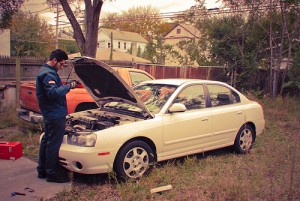Staying in Tune with Your Vehicle

It doesn’t matter if you drive a new or a used car, not keeping up with the maintenance of it can easily creep up on you when you least expect it. For instance, have you ever passed a new car stranded on the side of the road and wondered why it broke down in the first place? It’s a new car. What problems could it possibly have? Many people wonder that very same thing.
Surprisingly, many of these newer and used cars that you see broken down on the side of the road don’t have any major mechanical issues. In fact, many of these cars broke down or simply quit on their owners because of lack of simple maintenance or attention. Don’t find yourself stranded on the side of the road because you weren’t staying in tune with your vehicle.
Vehicle Maintenance Guide
The following vehicle maintenance tips will help you with staying in tune with your vehicle, ensuring the safety of you and your passengers.
Listen to Your Car
Many newer and older vehicles have the capability to tell you when minor maintenance needs to be performed. So, when you see a light indicating that you have low fluids or need your oil changed, do it as soon as possible.
If you see a check engine light or other light illuminated that you are unfamiliar with, immediately check your vehicle’s owner’s manual to see what it means. When in doubt, consult with a mechanic about replacement car parts. By ignoring a trouble light now, a small problem could easily turn into something big later on.
Change Your Fluids
Most manufacturers recommend that you change the oil in your vehicle every 3,000 miles, and change the transmission fluid in it every 30,000-60,000 miles. Of course, if you get heavy-duty use out of your car, you may need to change these fluids more often. Keep track of how many miles you drive monthly to improve on staying in tune with your vehicle.
Always Check Your Tires
Checking your tire pressure at least once a month is highly recommended. Even if your tires look fine, they could be low on pressure or have too much pressure. Driving on tires that are not at the correct pressure is not only dangerous, but doing so can also cause you to have a blowout and be stranded on the side of the road – potentially causing an accident.
Keep up with Your Brakes
Driving around in a car that you know is due for a brake job will not leave you stranded on the side of the road, but it is dangerous, and you could get into an accident because of it. Brake pads are generally inexpensive to replace out, even if you have a professional do it for you.
However, if you neglect to replace brake pads when they get low, you could end up with a much more expensive problem on your hands. Once you start wearing down the rotors, the cost for a brake job will rise considerably.
Change Your Spark Plugs
Many spark plugs nowadays can last up to 90,000 miles, but changing them before their time is up is often recommended. Not keeping up with the maintenance of the spark plugs can cause your car to run poorly, and could eventually leave you stranded when it doesn’t start.
Pay Attention to Your Timing Belt
When performing maintenance on your vehicle, take a few moments to look over your timing belt. Examine it for cracks, excessive slack, and wear. Also, if your timing belt is loose, you should hear it slapping under your hood. In any case, get your timing belt replaced as soon as possible. If a timing belt breaks while you are driving, you will be one of those cars, unfortunately, stuck on the side of the road.
Don’t Forget the Gas
Believe it or not, many people find themselves stranded on the side of the road simply because they forgot to put gas in their car, or figured they could get a few more miles on “E.” Don’t take a chance driving on empty. You never know where and when you might get stranded because of it.
Staying in tune with your vehicle is the best way to prevent expensive repairs and prolong the life of your car.


